Learning About Bicycle Commuters
Metro is trying to triple the number of bicyclists accessing our transit services by 2020. Our Bicycle & Pedestrian Access Improvements Study showed that although bicycling represents a small portion of station access now, this mode has very strong potential for growth. For example, many of our parking customers live less than 3 miles from their rail station, and many parking facilities fill up between 7:45 and 8:30 am.
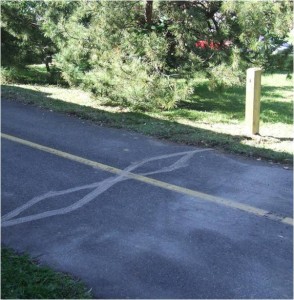
As part of this campaign, we are trying to learn more about the travel patterns of bicyclists so that we can better plan facilities and services for them. For example, how strong is the “seasonal” effect in biking? What time of day do cyclists ride? How does bicycling demand patterns compare to our rail and bus networks?
One source of data for these questions is the automatic bicycle counters that Arlington County has installed on the Custis Trail, a major trail for bicyclists between downtown, Arlington, and points west. This counter can sense the difference between a bicyclist and a pedestrian, and has been silently counting both since October 2009. The counter is located at the top of the hill between Rosslyn and Courthouse (map). Previous analyses of this data are available online.
While Custis Trail users certainly don’t necessarily represent current or potential bike-to-rail customers, they do provide some data-driven insight into the travel demand of bicyclists, whom we hope will be a key part to Metro’s long-term strategies for rail access. So, the rest of this post analyzes bicycle counts by 15-minute intervals between October 2009 and February 2011.
Seasonal Effects
Markers on the graph below are individual days, and the solid lines show a rolling 2-week average to smooth out the patterns and to compensate for weekends. Bicycling on the Custis reaches its height by about April, stays constant until mid-October, and then drops by December through February. March and November are the shoulders. Demand is not zero even in the coldest months – average “low season” demand is about a third of “high season.” There is no appreciable drop in bicycling even during the hottest months in the summer, as others have noted too.
This data also show that over the course of a year, the winter results in a loss of total bicycle trips of around 30%. That is, if demand stayed at its “high season” rate all year round, annual bike trips on the Custis Trail would be about 30% higher. This metric captures both the duration and the magnitude of the winter effect.
The dispersion of the dots in the graph show that bicycling demand is fairly variable on a day-to-day basis. Bicycling demand on the Custis Trail appears to be relatively more variable than the day-to-day consistency we typically see on Metro transit services.
The string of red zeroes in February 2010 show when the trail was covered in snow and ice and impassable for 2-3 weeks following two blizzards. Interestingly, during the same stretch in February 2011, the trail saw about 500 bicyclists per day. In total February 2010 was about 10,000 bike trips less than February 2011.
Metro sees seasonal effects on its bus and rail services, as well, for weather and other reasons (holidays, tourism, etc). But, the “winter effect” is not nearly as high, for obvious reasons!
Time-of-Day Effects
The next two graphs show a low, median, and high day by 15-minute intervals, out of about 500 days. Showing the median and then 25th and 75th percentiles gives us a reasonable range of normalcy. The really miserable cold or icy days, and also the spectacular, popular summer days aren’t shown here – this is the middle half. A few observations:
- Weekday bicyclists on the Custis Trail show a strongly-peaked commuter pattern.
- The morning peak is concentrated from 7:30 to 9am.
- Peak weekday bike demand is strong and steady. On good days (75th percentile, dark red below), the trail sustains an average flow of one bike every 20 seconds, or about 200 bicyclists per hour for about an hour between 7:30 and 8:30am, and then again between 5:15 and 6:15pm.
- Even throughout midday lull, there is on average one bike every 3 minutes on the trail
- On the below-average (25 percentile) days, presumably more often in winter, the morning peak is later, and the afternoon peak is earlier. This is probably due to the temperatures and sunlight in the winter. In the summer, bicycle commuters tend to lengthen their commutes, and the peaks shift to earlier and later in the day.
Time-of-Day Comparisons to Rail
- Bicyclists on the Custis appear to have similar “peaking” characteristics as rail passengers, although on a much smaller scale. Bicyclists on the Custis want to travel at similar times as Metrorail passengers.
- Bicycle commuting on the Custis reaches peak at around 8:15 – 8:30 am, which is slightly after many Metro parking facilities fill up (on average between 7:45am and 8:30am, depending on the station, not shown on the graph below), but slightly earlier than what the rail network experiences.
- Peak demand is 5 or 6 times midday demand – we experience a similar ratio (although slightly lower) on the rail system.
Day-of-Week Effects
The last chart shows total bicycles per day on a median day, by day of the week and by “high” and “low” seasons. On weekends in the summer, weekend totals are nearly as high as weekdays. In the winter, hardy weekday bicycle commuters appear to outnumber weekend riders. All weekdays appear to be more or less indistinguishable in terms of bicycle ridership, which is similar to the rail network. However, Fridays are often noticeably different from Monday-Thursdays on the rail network.
Implications for Metro
So what does this mean for Metro as we plan bicycle facilities and try to increase bicycle access to our services?
- Bicycle demand is out there, and it can be strong.
- Plan and size bicycle facilities based on peak demand. Hot weather does not suppress demand, and cold weather suppresses only 30% of annual trips.
- Measure bicycle demand across several days between mid-April and mid-October. Bicycle demand is relatively variable day-to-day – we can see significantly higher biking on a good (75th percentile) day compared to a median day.
- Bicycle commuters have similar temporal patterns of demand as our transit passengers.
- Provide sufficient space and security for bicycle parking. Because bicycling “peaks” after our parking facilities fill up, bicycling can help our customers who want to access the rail network but don’t want arrive at a station early in the morning.
- Keep bicycle access paths clear of snow and ice. Some bicyclists want to ride, and will ride in the winter – if we tend to the facilities.
- Weekend bicyclists may represent just as large a market as weekday commuters in the summer, but they are spread throughout the midday.
What do you think this data means for Metro? What did we miss?

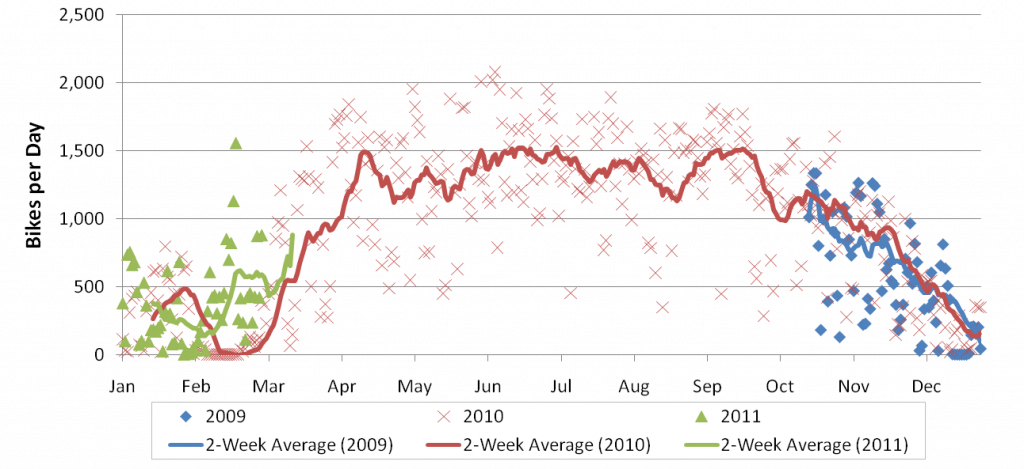
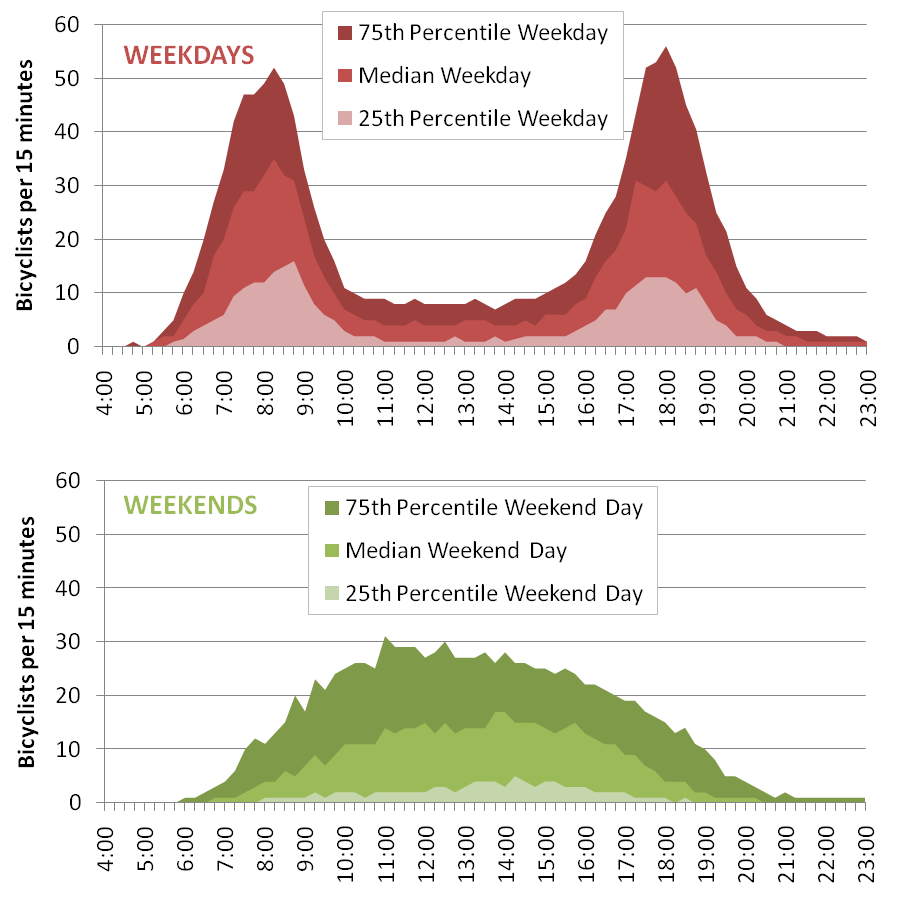
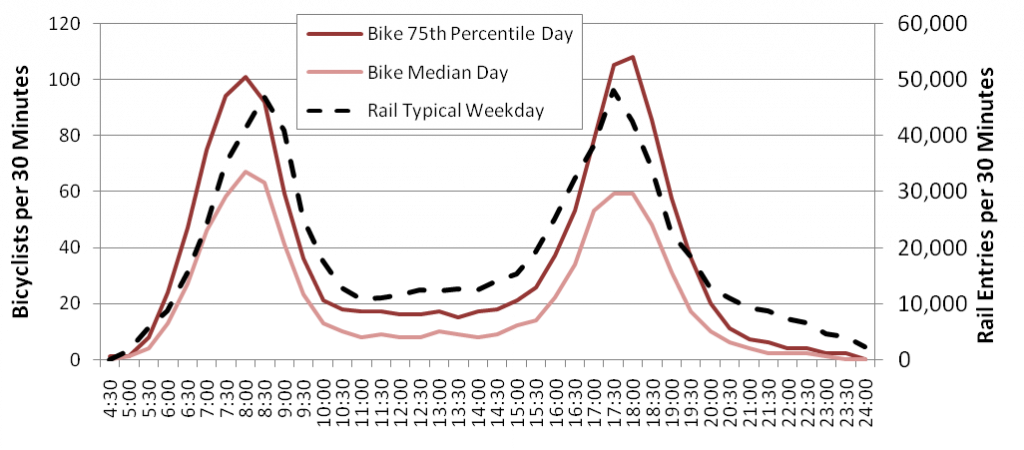
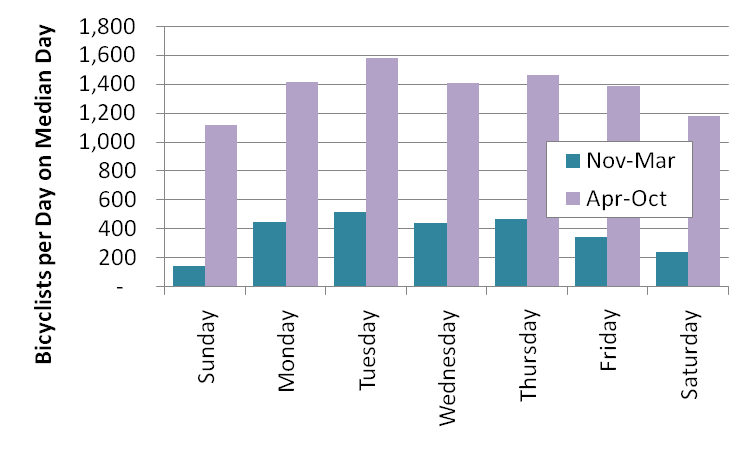

One note about commuting in winter unique to the Custis Trail (as opposed to, say, the Capitol Crescent or maybe just in the city) is that when ice covers the ground after snowfall or extreme low temperatures, it tends to stay for a long, long time afterwards in parts. This is due to the fact that there are lots of segments of the Custis Trail that are permanently in the shade due to noise walls or due to the frequent dips and hills along the trail. I’ve found this to be the biggest impediment to commuting in the winter (I live in Lee Heights).
What are your thoughts about coordinating with local municipalities to increase bike access to stations? I used to live six miles from the Shady Grove station. I would have loved to bike the but there was no safe route given the traffic patterns. Having said that a second problem for cyclists at that station is the lack of a cycling friendly entrance toi the grounds. So in addition to looking at peak travel times you should consider safe and convenient access to the suburban stations. I think your current data is very informative about bike commuting pattcerns among those riding from home to work. I bet the patterns of those who would ride bikes to metro stations would be much more informtive. Perhaps Metro could study the number of bikes parked at stations, what time they arrive and what time they depart. Also could perhaps put brief surveys on bikes parked at stations with nearby droppboxes to collect info from cyclists.
The success of Capital Bikeshare is worth noting: the one-way trips it facilities are natural feeders to Metro’s bus and rail systems, particularly during high demand times when the rail system cannot accommodate bikes on board. The time-of-day distribution closely follows the peaks noted in your post though midday and late evening usage seems to run proportionally higher (see http://www.codeline-telemetry.com/maps/depletion_yesterday.htm and scroll to graphs at the bottom of the page).
I’m a regular cyclist on the Custis Trail and I was hoping you could elaborate on the following statement:
On the below-average (25 percentile) days, presumably more often in winter, the morning peak is later, and the afternoon peak is earlier. This is probably due to the temperatures and sunlight in the winter. In the summer, bicycle commuters tend to lengthen their commutes, and the peaks shift to earlier and later in the day.
I commute by bike and by rail in inclement weather, but my hours at work do not change. I can’t work a shorter day in the winter and a longer day in the summer. Are there those that can adjust accordingly?
I would also advocate for more bike routes in the mile or three surrounding metro stations.
Also, on a selfish note, the entrance to West Falls Church from Haycock road is riddled with potholes over three inches deep. Extremely inhospitable to cyclists.
Greenbelt station doesn’t even have a bike lane on Greenbelt Metro drive. The intersection at Cherrywood Lane is hazardous. Stolen and vandalized bikes have been a problem, even during daylight hours, and the area around the bike lockers is often not cleaned up, especially in winter. I asked repeatedly for plowing or snowblowing in 2010, but didn’t get much help and ended up riding in with a shovel so I could do it myself. The bike lockers and bike parking areas aren’t visible from the station manager’s office, and there are no security cameras I don’t think. I used to ride to Greenbelt every day — had a locker. But with the locker fee increase, I dropped it.
I’m glad metro is now at least trying to get more cyclists, and I hope the College Park bike station works well. But for Greenbelt residents, all the little problems and indignities add up to a strong impression that metro doesn’t actually want bikes there. You have a long ways to go to lure me back.
Shawn: I suspect that the main reason the peak time shifts in winter is not because individual commuters are changing their commuting schedule, but rather that those who commute during warmer/brighter hours are more likely to stick it out through the winter. If I worked 9 to 5, I would be far more likely to bike in winter. Because I’m usually headed home at 7:30pm, it’s too much of a hurdle for me.
Hello,
This is some really interesting information – presented in a very useful way! Do you have any articles that speak to how you manage the data you collect? I work in Ontario where we are implenting an automated counter program. Any suggestions on how you clean and manage the data would be very useful!
Thanks,
L
@Shawn and @Jessica B – you’re right, I meant to say that the overall peaks move closer together in the winter; we can’t know from the data set whether individual commuters are shifting their patterns based on seasons.
@Nancy Seibel: We definitely intend to coordinate with local municipalities on bike/pedestrian access to stations. Unfortunately we don’t always own the land for access paths to stations, so working with local municipalities was a key recommendation in our Bicycle & Pedestrian Access Improvements Study.
Your ideas about surveying bike-to-rail riders are good ones, thanks! The bike/ped study (above) did survey bicyclists of all types about their current, and potential future, use of Metro. We are out counting parked bikes at stations now, and this Custis data has been informing the hours and weather during which we’re counting.
@Jeff: Greenbelt is on our list for bike parking and security improvements. We know we can and should improve, and I hope you stick with us.
Excellent analysis of Custis Trail counter data. Thank you for this. The Mount Vernon Trail sees very similar patterns overall. Weekend volumes are higher on the MVT, but even so, Mon-Fri use of the trail accounts for 2/3 of weekly counts. That ratio increases during coldest winter months. NPS has compared count data and strategies with Arlington County and plans to continue to do so. This was a really nice summary of data.
@Justin I think the most likely reason is people with short commutes are more likely to continue biking in cold months. You lose the longer commuters that would be on the trail earlier and later to get to work at the same time as people with shorter commutes. Without individual commuter info, this is all speculation, as you said.
Good for WMATA for trying, but what I don’t see is any improvement in the “take metro to work, and bike the last distance from the station” front. Not everywhere is easily walkable from Metro, but is easily bikeable, and adding a bus two directions each day gets expensive.
This is especially true for people who go from suburb to suburb. Fix that problem, and I might be off the road occasionally. I understand the rules in terms of no bikes at rush hour when heading into the city, but it’s a little silly when going opposite traffic (i.e. Bethesda to Shady Grove).
~EEE~
Even if the metro doesn’t improve the system for bringing bikes on the train you can look at folding bikes as an option. You can always get those on the train and unfold them to ride the last few miles to work. I use a Montague folding bike which feels just like a traditional bike. It has full size wheels, standard parts and a very solid folding mechanism.
@Justin
Justin, thanks for the response and additional info. It is great and very encouraging to know of your work.
@Rick
Excellent suggestion.
Agree with Justin. Enhancing bicycle parking options at metro stations only goes part of the way toward your goal of increasing metro access for bicyclists. The rush hour restrictions are currently my biggest impediment to using metro during my commute.
Section off the back half of the last car for bikes only, introduce a $.50 bike surcharge, or bore out the tunnels to make room for bike racks on top of the trains; lifting the rush hour restrictions would allow Metro to compete with Capital bikeshare for riders and further make the DC area one of the premier areas in the country for bicyclists..
Eric rather, though I hope Justin is working on exactly his point. @Matthew